Science fiction is a genre that asks us what we think the future could look like. For me, it was Star Trek: a hopeful vision of the future. But that’s all we could do: watch a vision of the future rather than truly experience it. This changes with the long-awaited arrival of Bethesda Studios' newest role-playing game, Starfield.
Announced in 2019, Bethesda Studios unveiled a tonal departure from games like Skyrim and Fallout 4. It was also their first original IP in 25 years since the original Elder Scrolls, not to mention the first instance of a Microsoft first-party by Bethesda Studios especially. There was a lot of weight put on the name Starfield for the past 5 years, and after more than 95 hours, I’m happy to say that if you’re someone who immerses themselves in these worlds, this too will be a game you will spend the next decade of your life in.
Choose your Own Adventure
You start the game, thrust into the role of a miner who uncovers a strange, unidentified object that grants them visions, kicking off an interstellar mystery. You’re then invited to a world called Jemison, to land in your very own spaceship in a glittering city of New Atlantis, to meet a mythical group of space explorers named Constellation so you can begin your journey.
Or don’t, It’s really up to you.
Much like Bethesda Studios' previous titles, Starfield is a role-playing game that truly lives up to the ideologies of the genre: once you have passed the introduction of the game, you can go wherever and do whatever you want. Starfield plays like the ultimate choose-your-own-adventure book, and it all starts with the character creation system
After the initial intro, players are given access to a robust character creator starting with how you look. This is easily Bethesda's deepest character creator to date, allowing you to manipulate almost anything about your character's body. Once you’ve established your look, the game asks you another question. Who are you?
Backgrounds allow players to find their place in the universe. Selecting the right one gives you three starting traits that give you skills and background-specific dialogue. After backgrounds, you can choose three additional traits that can be as simple as enhanced oxygen to as interesting as being able to visit your parents. The combination of an excellent character creator, backgrounds, and traits allows you to build your character the way you want, with plenty of variation for future playthroughs.
Once you’ve crafted your character, you’re ready to experience Bethesda’s best mainline campaign to date: a thrilling adventure across star systems and one of the best endings and post-games I’ve played in quite some time. If that wasn’t enough for you, each major faction in this game also comes with its own unique, memorable, and lengthy campaign that explores the different corners of the settled systems.
The game also features excellent side quests that reflect the many different characters and ideas of this brand-new universe, and while the level of quality might vary between them, there’s always an interesting story to be experienced.
Besides these stories, there’s also a vast amount of activities in this game that will keep you busy. Some of them are randomized quests you can get from mission boards like bounty hunting, transporting goods (or people), and even surveying worlds. While these tasks lack a narrative to them, they’re still fun and varied enough to always give players something to do, and ways to earn some credits.
Open World(s)
Starfield features over 1000 planets to explore, but not the way games like No Mans Sky or Elite Dangerous have handled it. Unlike the aforementioned space simulators, players can’t land on a planet seamlessly and then explore the world end-to-end. That’s probably because Starfield is not a space-sim, but a role-playing game set in space.
This is how space works in Starfield: you fly to a solar system either by selecting it through the fantastic star map or opening the scanner mode in-game and then selecting your destination. You’re then met by a nifty cutscene of initiating a “jump” and seconds later you arrive at your destination, met by another loading screen if you’re landing for the first time on a world, and then you’re ready to set foot on alien soil. While the loading screens may feel numerous compared to space sims, it gets players to their destination instead of spending time just flying. With that said, while you are flying around, you will come across plenty of points of interest in space that add some spice to your journey.
On the ground, Starfield handles exploration via “landing zones.” When players approach a world, they can select any point on the planet to land on. The game then builds the open world around them: a map that is comparable to that of Skyrim or maybe more. Each point you then select on the world will create another landing zone to explore: a combination of bespoke campaign content, interesting pre-determined landing zones, and procedurally generated ones. One thing I absolutely loved about Starfield’s worlds is the fact that they have different biomes: the same world can have mountains, deserts, forests, and more.
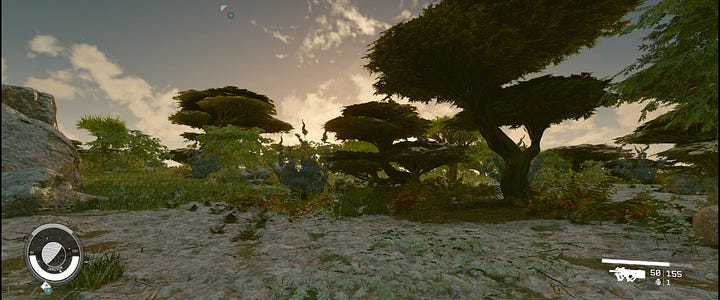
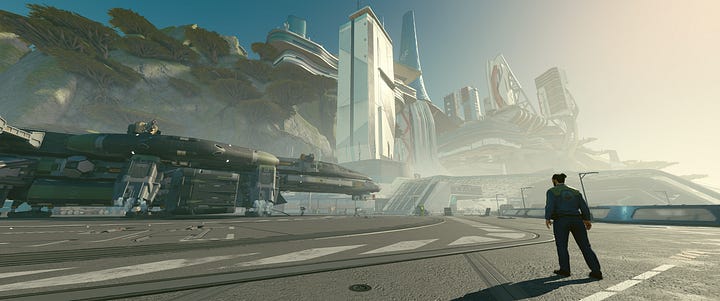
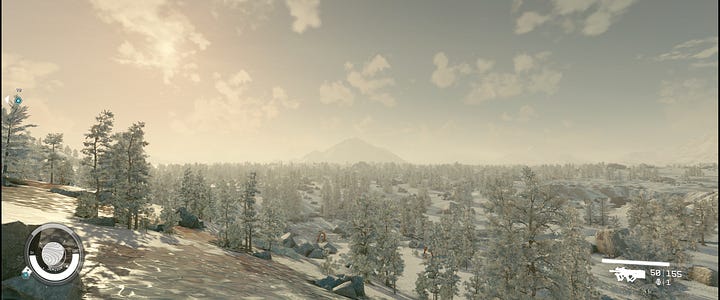

Starfield’s UI is one of the more problematic areas of the game which can at times feel too minimalist. The game’s zone maps which can be accessed via the system menu or scanner tool are a simplistic topographical representation of the area around you highlighting places you’ve visited and are waiting to be discovered. While this simplistic view is serviceable for exploration in these landing zones, it gets quite confusing when visiting major cities.
That being said, the game in a way does encourage you to learn the city through a diegetic process where you learn through immersing yourself and not staring at a map. If this was the goal intended by Bethesda, then it was not explained well.
Star-to-Star Wars
Combat in Starfield is fantastic; it is easily the best-playing shooter Bethesda has created. While it’s not perfect, it does a fantastic job creating tense combat scenarios especially when paired with an immense amount of ranged and melee weapons, a thrilling (and expandable) boost pack, and as evidenced during a short tease during the lengthy Starfield Direct back in June, a bit of space magic.
Starfield's combat is further elevated with fantastic animation work. Movement feels responsive and looks more fluid in third-person, enemies react realistically depending on where they’re hit and there’s just something fun about seeing your character flying across the face of a moon in low gravity, tossing mines like frisbees. The A.I. in the game unfortunately hasn’t evolved at the pace of its animation prowess, with rare moments of ineptitude by the enemies in the game.
But the real star of the combat in this game, are the ridiculous physics in Starfield. Each planet has its own unique gravitational conditions: some worlds are heavier, some you’re flying across the landscape. Physics isn’t limited to just characters, but to every interactable object in this game: and there are a lot of interactable objects. Unlike most games where objects are simply set decor, Starfield features an astonishing amount of interactable, collectible physics-based objects that react realistically.
One example that comes to mind is boarding a derelict transport ship taken over by the Crimson Fleet where the artificial gravity keeps cutting in and out. Walking around the interiors you’ll see various objects suddenly start floating realistically around the environment, bouncing off both the fixed objects and yourself, reacting to gunfire, etc.
When you’re not running and gunning, you might be flying and gunning with Starfield’s space flight mechanics. From the opening hours, you’re given control of your very own spaceship that is fully customizable from ship systems to the design and the paint job. I’m pretty sure a good chunk of my playtime was spent in the shipbuilder mode; a lot of that is thanks to the fact that it’s not just for show, but a complex dance of balancing power systems based on various factors. Once you are in space, dogfighting right away doesn’t feel like an afterthought but a thrilling addition to Bethesa’s loop, especially when you get a hang of it.
Starfield also sports a robust crafting/research and outpost building where much like Fallout 4 you can build your home among the stars. With the extensive amount of content in this game, I haven’t had much time to dig into the crafting and outpost building simply because it takes quite a while to level up. What time I did spend on outpost building, thus far, did feel a little less flexible as the system in Fallout 4 mainly could be attributed to the fact I haven’t spent enough points to level up the skills needed.
Visions of the Future
Starfield combines the NASA Punk design aesthetic with their own views of the future to create realistically rendered worlds, cities, caves, desolate rocks and so much more. All in all, Starfield is a very beautiful game: interiors are highly detailed, cities look gorgeous, and even small details like the prop design have to be applauded. The amount of detail in these objects is stunning, which exemplifies of feeling like you’re in this world.
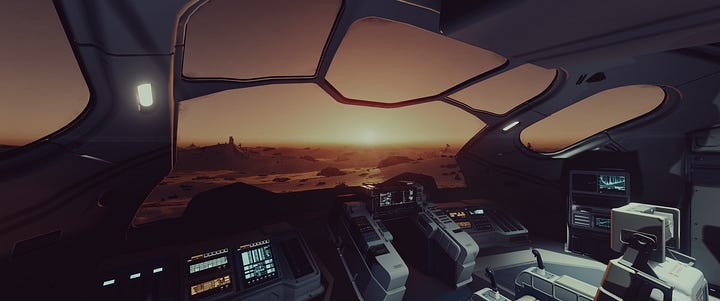
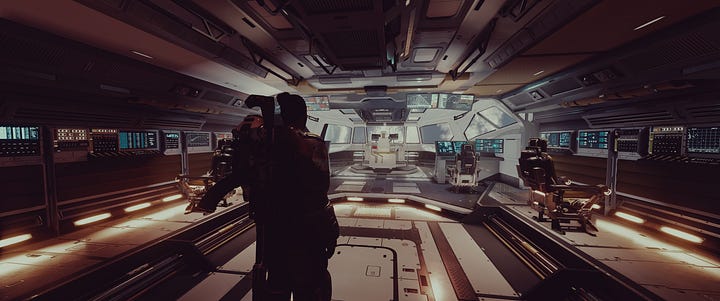
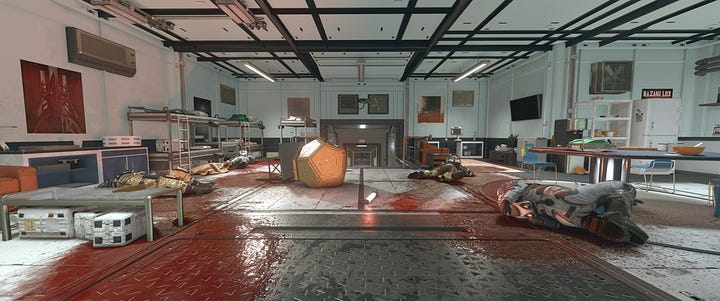
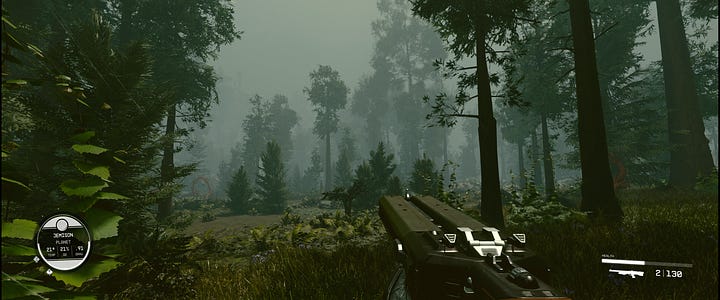
The people of the Settled Systems however do continue the tradition of character models that feel a tad bit behind the curve. They are mostly leaps and bounds better than Fallout 4 and in some cases do look great, but then in some scenarios especially in certain lighting conditions, do look dated including facial animations, which are luckily given more life with the excellent voice acting.
Starfield is littered with various characters, with voice performances ranging from okay to fantastic, especially with companions like Sam Coe, portrayed by Elias Toufexis of Deus Ex and The Expanse (and so much more) fame. Bethesda also significantly fleshes out inter-NPC dynamics: Sam Coe’s relationship with his daughter, and Sarah Morgan’s relationship with characters from her past, all of which add to making this universe feel lived in.
Starfield’s sound design is a crowning achievement, bringing life to worlds and characters in places where it could need a bit more support. Desolate moons feel isolating and cold while bustling cities reverberate with noise and all manners of characters. One of my favorite things to do is just hang around a launch pad, waiting for a random vessel to boom into the atmosphere, and hearing the sounds emanating from it as it corrects its course to land. Starfield is a game that sounds as alive as it looks.
Supporting this incredible sound design is an exemplary soundtrack by Inor Zur, the composer of games like Fallout 4 and The Elder Scrolls Online. Zur crafts together a compelling soundscape of this distant future, with a range of tones that instill the love for discovery, the fear of the endless depths of space, and everything else in between. Bethesda has always had an exemplary record of fantastic soundtracks, and it’s exciting to finally experience their vision of a future in the stars through Zur’s phenomenal soundtrack.
Diagnostic Check
They did it. Starfield is the least buggiest Bethesda game I’ve ever played. In my lengthy playthrough, I’ve had fewer bugs than some other major games released this year. It’s almost sad in a way since I do associate funny bugs with their titles, but I’m also happy to see their hard work pay off. There are still bugs in the game, but nothing game-breaking whatsoever.
Starfield is also a game that runs quite well. On console, there were some concerns about the Series X version of the game being locked at 30 frames-per-second, and after seeing the scale and complexity of physics involved it is completely understandable. Though I do still wish they include a performance mode in the future, the frame rate is a solid 30 with little dips.
PC performance on an RTX3070 is also quite good. Playing on a 50/50 High-to-Ultra setup, I’m getting 60+ on most worlds and interiors, 50-60 in major cities with some major drops to 40’s on worlds with a lot of foliage. Overall though, it’s quite good and with their plans to include DLSS in the future, it will only get better.
What I do find disappointing is the lack of very standard settings like field of view: I had to go into my .ini files to change the values so I could make it feel more natural. This and some other key features like no brightness/contrast sliders and HDR are completely missing. Bethesda has noted that these features are coming, but it’s strange to see this be an “update” than right out of the box.
The Field of Stars, Measured
Starfield is an enormous game. It is also an enormous achievement for Bethesda Studios and every single person who poured their heart and soul into this game.
The game is not perfect: missing settings that should be second nature, character models that feel a bit dated, the lack of local maps or generally being thrust into a universe without any guidance, A lot of these things may seem like they hurt the overall experience. I believe these shortcomings are made up for in spades by offering players the best campaign by the studio, a host of great characters, a litany of systems and mechanics to learn, and near-endless opportunities to explore and discover what's out there.
There will be an inevitable conversation about whether Starfield deserves the title of “Game of the Year” or not, a title that is subjective. What I can say is, this is without a doubt my game of the year, surpassing Fallout 4 and in some ways Skyrim, while simultaneously reminding us why a Bethesda release is so special.
Whatever the conversation might be among my peers and others, there is one fact: Starfield will be a game that will be talked about and most importantly “played,” for another decade to come.
Starfield is a 10 out of 10.
Let us know in the comments or on social media if you’ve been playing! (Twitter // Instagram // Facebook)




















